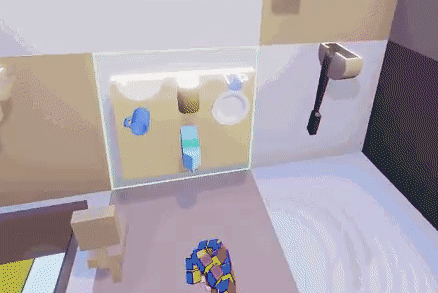Rubi’s Room tests what it’s like to solve a life-sized Rubik’s Cube in VR

Rubi’s Room wasn’t always in virtual reality, but gazing at its perfectly dizzying human Rubik’s Cube antics, it wouldn’t be surprising to think it was. The game was borne during the latest Ludum Dare game jam, but in a much simpler 2D state. But for Germany-based developer David Hagemann, the idea of reworking the project for VR was on his mind all along.
“The immersion and the natural interaction [of VR] are the most compelling factors for me, it is not comparable to what you’re used to with playing games the regular way,” wrote Hagemann over email. “This brings a lot of problems and challenges with it, things that worked flawlessly in non-VR games can look and feel just wrong or cheap in VR.” Rubi’s Room, in its most basic essence, works similarly to its 2D version: the player shifts a room-shaped puzzle like a Rubik’s Cube, to make everything match again.
You are the Rubik's Man trying to solve the world #screenshotsaturday #LDJAM #UE4 pic.twitter.com/lv70HEZIer
— David Hagemann 🍉 (@TocoGamescom) December 17, 2016
The new Rubi’s Room reiteration has gained traction on Twitter, after Hagemann has regularly shared gifs of the development process—spotlighting both the positives and challenges he’s faced over the course of its re-development. “One of the challenges in VR is that you can’t have a HUD (sticking anything on the players view is pretty much the worst you can do in VR) and all those scores and text you see pop up in games look cheap in VR and they go against the immersion aspect,” wrote Hagemann, but the developer found a solution to the pointed problem: by making the text pop out into the world itself. “The text being in the physical world is a radical experiment [I did] to [work] around all these problems, [even if] the piling up of the text in the room is obviously a bit annoying at some point.”

As I watched the human VR Rubik’s Cube be shifted and put together time and time again along Hagemann’s Twitter timeline, my first thought was how impossible the pieces fitting together all looked. I wondered, for the folks like me who have never solved a Rubik’s Cube, was their hope for us in the digital VR puzzle room? Luckily, Hagemann’s solution to this is easy, he explained. He implemented miscellaneous game modes to solve potential issues. Whether it’s playing a Match-3 mode, or otherwise.
Hagemann got his start in game design as a teenager with Flash, where he would make “simple games just for fun.” He continued to pursue his knack for game making over the years—from interning at a two-man company that made 3D browser games, to becoming a freelance artist later in life. His first commercial game was Last Knight, a 3D platformer with a twist: “ragdoll driven jousting.”
You can follow Hagemann on Twitter for regular gif updates of the VR edition of Rubi’s Room. You can download the game’s original 2D version on itch.io here.



